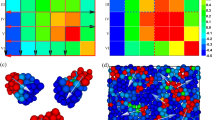Abstract
It has been widely accepted that spherical periodicity generally dominates liquid and amorphous structure formation, where atoms tend to gather near spherically periodic shells according to Friedel oscillation. Here we revealed that the same order is just hidden in the atomic global packing modes of the crystalline phases relevant to bulk metallic glasses. Among the nearest-neighbor clusters developed from all the non-equivalent atomic sites in a given phase, there always exists a principal a principal cluster, centered by which the spherical periodicity, both topologically and chemically, is the most distinct. Then the principal clusters plus specific glue atoms just constitute the cluster-plus-glue-atom structural units shared by both metallic glasses and the corresponding crystalline phases. It is further pointed out that the spherical periodicity order represents a common structural homology of crystalline and amorphous states in the medium-range through scrutinizing all binary bulk-glass-relevant phases in Cu-(Zr, Hf), Ni-(Nb, Ta), Al-Ca, and Pd-Si systems.
摘要
球周期在液体与非晶的结构形成过程中占有主要地位, 根据Friedel振荡理论, 原子倾向于聚集在球周期壳层上. 本文提出在非晶晶体相结构中依然隐藏着球周期序列. 在一个给定的相中, 所有非等效原子占位皆衍生出相应的最近邻团簇, 其中必然存在一个具有代表性的主团簇, 以其为中心时, 球周期最明显. 该主团簇加上特定的连接原子组成了对应非晶态的团簇加连接原子结构单元. 本文通过全面分析Cu-(Zr, Hf), Ni-(Nb, Ta), Al-Ca与Pd-Si二元块体非晶形成体系中的晶化相, 进一步指出球周期序代表了晶态与非晶态在中程序的结构同源性.
Similar content being viewed by others
References
Häussler P. Interrelations between atomic and electronic structures —liquid and amorphous metals as model systems. Phys Rep, 1992, 222: 65–143
Friedel J. Electronic structure of primary solid solutions in metals. Adv Phys, 1954, 3: 446–507
Häussler P, Barzola-Quiquia J. Spherical periodicity, an intermediate step to long-range order. J Non-Crystalline Solids, 2002, 312-314: 498–501
Han G, Qiang J, Li F, et al. The e/a values of ideal metallic glasses in relation to cluster formulae. Acta Mater, 2011, 59: 5917–5923
Luo L, Chen H, Wang Y, et al. 24 electron cluster formulas as the ‘molecular’ units of ideal metallic glasses. Philos Mag, 2014, 94: 2520–2540
Liu X, Xu Y, Hui X, et al. Metallic liquids and glasses: atomic order and global packing. Phys Rev Lett, 2010, 105: 155501
Wu Z, Li M, Wang W, et al. Hidden topological order and its correlation with glass-forming ability in metallic glasses. Nat Commun, 2015, 6: 6035
Dong C, Wang Q, Qiang J, et al. From clusters to phase diagrams: composition rules of quasicrystals and bulk metallic glasses. J Phys D-Appl Phys, 2007, 40: R273–R291
Häussler P. A new hume-rothery phase with an amorphous structure in noble-metal/simple-metal alloys. J Phys Colloques, 1985, 46: C8–361–C8–365
Bernal J. Geometry of the structure of monatomic liquids. Nature, 1960, 185: 68–70
Gaskell P. A new structural model for transition metal–metalloid glasses. Nature, 1978, 276: 484–485
Miracle D. The efficient cluster packing model–an atomic structural model for metallic glasses. Acta Mater, 2006, 54: 4317–4336
Chen J, Wang Q, Wang Y, et al. Cluster formulae for alloy phases. Philos Mag Lett, 2010, 90: 683–688
Du J, Wen B, Melnik R, et al. Determining characteristic principal clusters in the “cluster-plus-glue-atom” model. Acta Mater, 2014, 75: 113–121
Dong D, Zhang S, Wang Z, et al. Composition interpretation of binary bulk metallic glasses via principal cluster definition. Mater Des, 2016, 96: 115–121
Harrison WA. Solid State Theory. New York: McGraw-Hill, Inc., 1970
Ziman JM. Principles of the Theory of Solids. Cambridge: Cambridge university press, 1972
Hafner J, Heine V. The crystal structures of the elements: pseudopotential theory revisited. J Phys F-Met Phys, 1983, 13: 2479–2501
Kroha J, Huck A, Kopp T. Coulomb interaction and disorder at q=2kF: a novel instability of the Fermi sea and implications for amorphous alloys. Phys Rev Lett, 1995, 75: 4278–4281
Zallen R. The Physics of Amorphous Solids. New York: John Wiley & Sons, Inc., 1983
Wang Z, Qiang J, Wang Y, et al. Composition design procedures of Ti-based bulk metallic glasses using the cluster-plus-glue-atom model. Acta Mater, 2016, 111: 366–376
Wang Z, Dong D, Zhang S, et al. Characteristics of cluster formulas for binary bulk metallic glasses. J Alloys Compd, 2016, 654: 340–343
Zhang S, Dong D, Wang Z, et al. Composition formulas of Ni-(Nb, Ta) bulk metallic glasses. Intermetallics, 2017, 85: 176–179
Huang B, Corbett J. Two new binary calcium-aluminum compounds: Ca13Al14, with a novel two-dimensional aluminum network, and Ca8Al3, an Fe3Al-type analogue. Inorg Chem, 1998, 37: 5827–5833
Hong H, Wang Q, Dong C, et al. Understanding the Cu-Zn brass alloys using a short-range-order cluster model: significance of specific compositions of industrial alloys. Sci Rep, 2014, 4: 7065
Hong H, Wang Q, Dong C. Composition formulas of Cu-Ni industrial alloy specifications. Sci China Mater, 2015, 58: 355–362
Acknowledgements
This work was supported by the Science Challenge Program (JCKY2016212A504) and the National Natural Science Foundation of China (11674045).
Author information
Authors and Affiliations
Corresponding author
Additional information
Shuang Zhang is a PhD candidate majored in condensed matter physics at the School of Materials Science and Engineering in DUT. Her research interests include structural modeling of metallic glasses and solid solutions, composition design of alloys, structural origin of simple crystals, and structural homology between ordered and the corresponding disordered states.
Chuang Dong is a professor at the Key Laboratory of Materials Modification, DUT. He obtained his PhD degree in materials science in 1991 at INPL, France. He owned the titles of the Outstanding Young Researcher in 1995 and Changjiang Professor in 2005, respectively. His research interests include structural modeling of disordered materials, alloy design, and surface modification.
Rights and permissions
About this article
Cite this article
Zhang, S., Dong, D., Wang, Z. et al. Spherical periodicity as structural homology of crystalline and amorphous states. Sci. China Mater. 61, 409–416 (2018). https://doi.org/10.1007/s40843-017-9161-4
Received:
Accepted:
Published:
Issue Date:
DOI: https://doi.org/10.1007/s40843-017-9161-4




